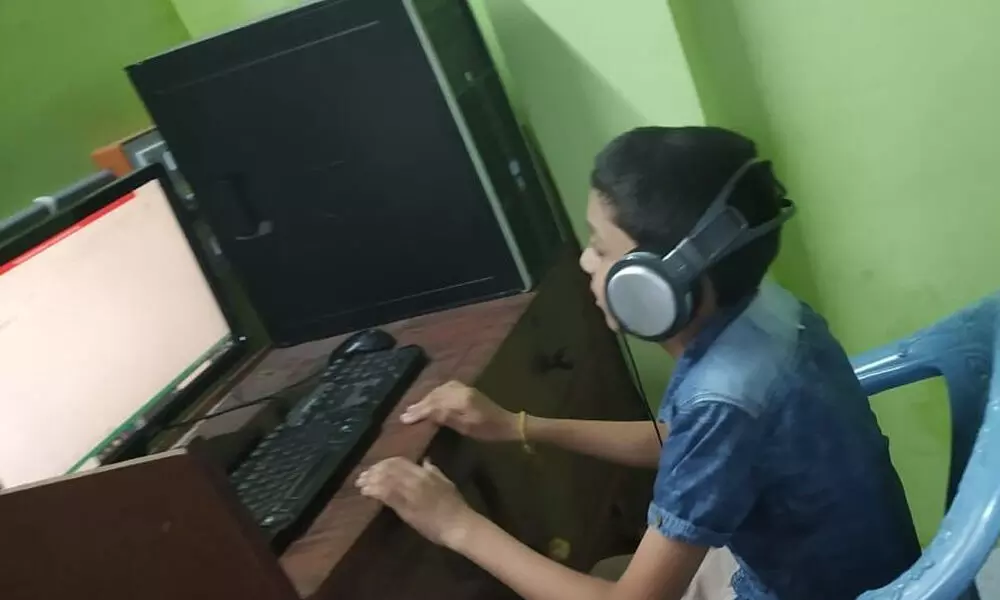Live
- First Star Outside Milky Way Captured: WOH G64 is 2,000 Times Larger Than the Sun
- Sikkim govt to constitute state Niti Ayog: CM Tamang
- CBI books Rajasthan narcotics inspector for Rs 3 lakh bribe
- Rajasthan bypolls: A tough contest between BJP and Congress
- Albania joins SEPA, paving way for EU integration
- Japanese government approves 250-billion USD economic package to ease price pain
- Six pharma companies to set up their units in Telangana
- The Unstable Events of a 17-Wicket Day in Perth: India vs Australia
- Dutch FM's Israel trip cancelled after Netanyahu's arrest warrant
- UK to increase energy price cap by 1.2 per cent
Just In

They are found to spend 35% of time on online games and recreation
Hyderabad: Poor ergonomics is taking a toll on children as they spend long hours online either studying or for entertainment. According to a latest study conducted by Prof Maj S Bakhtiar Choudhary (Retd) reveals that students in the city are affected by several health issues during lockdown as they were forced to stay indoors.
Not aware of the problems associated with acquired incorrect postures such as Repetitive Strain Injury (RSI), Cumulative Trauma Disorders (CTDs) and MSD's (musculoskeletal disorders) many students in the age group 10-17 years of both sexes are affected by upper back pain 21%, lower back pain 18%, wrist and hand pain 6%, dry eye syndrome 13%, headache 11%, insomnia 8% and behavioral changes 6%.
The survey was conducted 60 days after the first day of lockdown in Hyderabad (23 March, 2020) with a sample of 186 children aged between 10-17 years of both sexes. An interesting finding of the survey is schools never teach ergonomics and it is not a part of the curriculum. Children now spend close to 5-7 hours studying and working with gadgets. 'There is a need to integrate the importance of ergonomics considering the new normal as online teaching is now commonplace," says Dr Bakhtiar Choudhary.
Adults who work in an uncomfortable position tend to take breaks and relax after the work hours. Often children skip their much-needed breaks. Prolonged sitting coupled with wrong ergonomics leads to wrong posture, resulting in increase in risk for neck and back pain.
Young children (stature less than 145cm) cannot fit into standard chair and computer workstations, our study revealed that many children couldn't reach their feet on floor while working thus forcing them to work in slouch posture with forward head posture.
Asthenopia, an eye fatigue syndrome, is experienced by young children while viewing at laptop/PC/Android monitors for a long period. Frequent focusing on different size of fonts, colours, and moving screens cause severe strain on rectus and oblique muscles of the eye ball, more so, in spectacle wearers. Children have a tendency not to blink their eyes often while watching interesting subjects on screen thus lacrimation of eyeball is reduced and it causes dryness and redness of the eyes.
Direct or indirect glare, incorrect eye monitor ergonomics are responsible for eye strain and headache and it may lead to myopia early in life. Headache, irritation and insomnia may attribute to prolonged exposure to microwave radiation from gadgets and boredom due to lockdown itself.
WHAT THE FINDINGS SAY
• There are no readymade gadgets and furniture to suit every child. It is important to understand, learn and practice sound ergonomics.
• Teachers, parents and children must be trained in fundamentals of workstation ergonomics. it should be incorporated in their school curriculum
• Tall and short statured children need customised workstations
• It is impossible to provide correct ergonomics for Smart phones and Tabs
• Laptops need special arrangement such as external keyboard &mouse
• Children should be encouraged to have frequent micro breaks from their sitting
• School curriculum should include ant-RSI deskbound stretches and recreational games
• Children with MSD's and RSI's should be treated by Occupational health and Sports physicians.

© 2024 Hyderabad Media House Limited/The Hans India. All rights reserved. Powered by hocalwire.com







